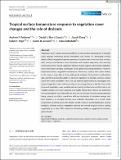Tropical surface temperature response to vegetation cover changes and the role of drylands
Author(s)
Feldman, Andrew F; Short Gianotti, Daniel J; Dong, Jianzhi; Trigo, Isabel F; Salvucci, Guido D; Entekhabi, Dara; ... Show more Show less
DownloadPublished version (3.302Mb)
Publisher with Creative Commons License
Publisher with Creative Commons License
Creative Commons Attribution
Terms of use
Metadata
Show full item recordAbstract
Vegetation cover creates competing effects on land surface temperature: it typically cools through enhancing energy dissipation and warms via decreasing surface albedo. Global vegetation has been previously found to overall net cool land surfaces with cooling contributions from temperate and tropical vegetation and warming contributions from boreal vegetation. Recent studies suggest that dryland vegetation across the tropics strongly contributes to this global net cooling feedback. However, observation-based vegetation-temperature interaction studies have been limited in the tropics, especially in their widespread drylands. Theoretical considerations also call into question the ability of dryland vegetation to strongly cool the surface under low water availability. Here, we use satellite observations to investigate how tropical vegetation cover influences the surface energy balance. We find that while increased vegetation cover would impart net cooling feedbacks across the tropics, net vegetal cooling effects are subdued in drylands. Using observations, we determine that dryland plants have less ability to cool the surface due to their cooling pathways being reduced by aridity, overall less efficient dissipation of turbulent energy, and their tendency to strongly increase solar radiation absorption. As a result, while proportional greening across the tropics would create an overall biophysical cooling feedback, dryland tropical vegetation reduces the overall tropical surface cooling magnitude by at least 14%, instead of enhancing cooling as suggested by previous global studies.
Date issued
2022Department
Massachusetts Institute of Technology. Department of Civil and Environmental EngineeringJournal
Global Change Biology
Publisher
Wiley
Citation
Feldman, Andrew F, Short Gianotti, Daniel J, Dong, Jianzhi, Trigo, Isabel F, Salvucci, Guido D et al. 2022. "Tropical surface temperature response to vegetation cover changes and the role of drylands." Global Change Biology, 29 (1).
Version: Final published version